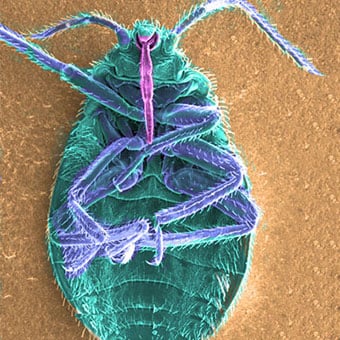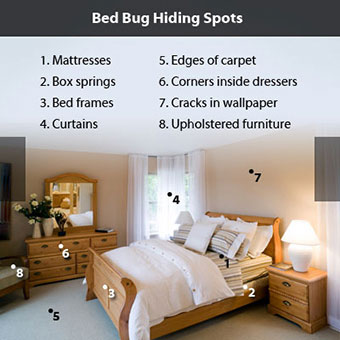Bed Bugs Bites
- Facts
- What They Look Like
- Where Are They?
- Hotels
- How They Spread
- Symptoms & Signs
- Bite Treatment
- Bite Remedies
- Detection
- How to Get Rid of Them
- Bite Prognosis
- Prevention

What should you know about bed bugs?
Bed bugs (Cimex lectularius) are small, oval insects that feed by sucking blood from humans or other warm-blooded animals. The effect of bed bugs on human health and reports of bedbug infestations of certain hotels has received media attention in recent years.
How big are bed bugs?
Bed bugs do not fly. Adult bed bugs are 5-7 mm in length.
Where do bed bugs live?
Bed bugs are pests that can live anywhere in the home. They can live in cracks in furniture or in any type of textile, including upholstered furniture. Bed bug infestations are most common in beds, including the mattress, box springs, and bed frames. Bed bugs are most active at night. These pests may bite any exposed areas of skin while an individual is sleeping. Common locations for bed bug bites are the face, neck, hands, and arms.
Are bed bug bites painful?
A bed bug bite is painless and is generally not noticed. The bites may be mistaken for a rash of another cause. Small, flat, or raised bumps on the skin are the most common sign. Symptoms include redness, swelling, and itching.
How do you know if you have bed bugs?
Fecal stains or rust-colored dark spots, egg cases, and shed skins (exuviae) of bed bugs in crevices and cracks on or near beds are suggestive of infestations, but only observing the bugs themselves can confirm an active infestation. A professional pest-control company may be required to help identify and remove bed bugs from the home.
What home remedies and medications treat and get rid of bed bugs?
Home remedies for bed bug bites include measures to control itchings, such as oatmeal baths or cool compresses. Typically, no treatment is required for bed bug bites. If itching is severe, steroid creams or oral antihistamines may be used for symptom relief.

What are bed bugs? What do bed bugs look like?
Bed bugs are small oval-shaped non-flying insects that belong to the insect family Cimicidae, which includes three species that bite people.
- Adult bed bugs reach 5 mm-7 mm in length, while nymphs (juveniles) are as small as 1.5 mm.
- Bed bugs have flat bodies and may sometimes be mistaken for ticks or small cockroaches. Bed bugs feed by sucking blood from humans or animals. Cimex lectularius is the scientific name for bed bugs.
Adult bed bugs are reddish-brown in color, appearing engorged and more reddish after feeding on a blood meal. Nymphs are light-colored and appear bright red after feeding. The wings of bed bugs are vestigial, so they cannot fly. However, they are able to crawl rapidly.
Temperatures between 70 F-80 F are most favorable for bed bugs, allowing them to develop into adults most rapidly and produce up to three generations per year.

Where are bed bugs found?
Bed bugs are found all over the world. Bedbug infestations were common in the U.S. before World War II and became rare after widespread use of the pesticide DDT for pest control began in the 1940s and 1950s. They remained prevalent in other areas of the world and, in recent years, have been increasingly observed again in the U.S. Increases in immigration and travel from the developing world as well as restrictions on the use of stronger insecticides may be factors that have led to the relatively recent increase in bedbug infestations. While bedbug infestations are often reported to be found when sanitation conditions are poor or when birds or mammals (particularly bats) are nesting on or near a home, bed bugs can also live and thrive in clean environments. Crowded living quarters also facilitate the spread of bedbug infestations.
- Bed bugs can live in any area of the home and use tiny cracks in furniture as well as textiles and upholstered furniture as hiding places.
- They tend to be most common in areas where people sleep and generally concentrate in beds, including mattresses or mattress covers, box springs, and bed frames.
- They do not infest the sleeping surfaces of beds as commonly as cracks and crevices associated with the bed frame and mattress, including mattress seams.
- Other sites where bed bugs often reside and potentially infested items include
- curtains,
- edges of carpet,
- corners inside dressers and other furniture,
- cracks in wallpaper (particularly near the bed), and
- inside the spaces of wicker furniture.
Since bed bugs can live for months or even longer under favorable conditions without feeding, they can also be found in vacant homes.
Are bed bugs found in hotels?
Many news reports in recent years have focused on the discovery of bed bugs in even upscale hotels, and a number of lawsuits have been filed by guests in these fashionable hotels who awoke to find hundreds of bedbug bites covering their skin. Searching on travel-review websites regularly reveals information and even photos confirming the presence of bedbugs in numerous hotels.
Since bed bugs can arrive on the clothing or in the suitcases of guests from infested homes or other hotels harboring the pests, hotels can be an easy target for bedbug infestations.
In addition to hotels, bed bugs have been found in
- movie theaters,
- office buildings,
- laundries, shelters,
- in transportation vehicles, and
- other locations where people may congregate.

How do bed bugs spread?
- Bed bugs live in any articles of furniture, clothing, or bedding, so they or their eggs may be present in used furniture or clothing.
- They spread by crawling and may contaminate multiple rooms in a home or even multiple dwellings in apartment buildings.
- They may also hide in boxes, suitcases, or other items that are moved from residence to residence or from a hotel to home.
- Bed bugs can live on clothing from home infestations and may be spread by a person unknowingly wearing infested clothing.
What are the symptoms and signs of bed bug bites?
Bed bugs bite and suck blood from humans. Bed bugs are most active at night and bite any exposed areas of skin while an individual is sleeping. The face, neck, hands, and arms are common sites for bedbug bites. The bite itself is painless and is not noticed. Small, flat, or raised bumps on the skin are the most common sign;
- redness,
- swelling, and
- itching commonly occurs.
If scratched, the bite areas can become infected. A peculiarity of bedbug bites is the tendency to find several bites lined up in a row that may appear as itchy welts after scratching. Infectious-disease specialists refer to this series of bites as the "breakfast, lunch, and dinner" sign, signifying the sequential feeding that occurs from site to site. In some people, the bites can take several days to develop. The signs may become apparent up to 14 days after the bite has occurred.
Bed bug bites may go unnoticed or be mistaken for flea or mosquito bites or other types of rash or skin conditions since the signs of bedbug bites are difficult to distinguish from other bites or skin conditions. Bed bugs also have glands whose secretions may leave musty odors, and they also may leave dark fecal spots on bed sheets and around places where they hide (in crevices or protected areas around the bed or anywhere in the room).
Researchers have not conclusively proven that bed bugs carry or transmit diseases. However, health researchers have suggested that bed bugs may be possible vectors of American trypanosomiasis (Chagas disease) in areas where this disease is endemic, but they have not conclusively proven this.
What is the treatment for bed bug bites?
- Typically, no treatment is required for bed bug bites.
- If itching is severe or if an allergic reaction to the bites occurs,
- topical steroid creams or oral antihistamines may be used for symptom relief.
- Secondary bacterial infections that develop over heavily scratched areas may require antibiotics.
What are home remedies for bed bug bites?
- Home remedies for bed bug bites include anything that relieves and controls itching, such as cool compresses, oatmeal baths, or a paste made of baking soda and water.
- Home remedies can also include over-the-counter medications to combat itching, such as antihistamines.
How do I detect a bed bug infestation in my home or in a hotel?
- Check to see if you can identify the rust-colored fecal stains, egg cases, and shed skins (exuviae) in crevices and cracks on or near beds.
- A sweet, musty odor is sometimes present.
- You should also look at other areas such as under wallpaper, behind picture frames, in couches and other furniture, in bedsprings and under mattresses, and even in articles of clothing.
- While fecal stains and skin casts suggest that bed bugs have been present, these do not confirm that the infestation is still active.
- Observing the bed bugs themselves is definitive confirmation that an area is infested.
- You may require professional assistance from a pest-control company in determining whether your home has a bed bug problem.

How do you get rid of bed bugs in your home?
Getting rid of bed bugs is not an easy process, and most cases of bed bug infestation will require bedbug control treatment by a pest control expert or exterminator. Bed bugs can survive for up to a year without feeding, so they may persist even in unoccupied rooms.
A variety of low-odor sprays, dust, and aerosol insecticides help with bedbug control. People must apply these insecticides to all areas where the bugs are observed as well as hiding places or spaces where they may crawl. The pest control firm can help you determine if an infested mattress can be disinfected or must be discarded. Since beds cannot readily be treated with insecticides, it's often necessary to discard infested mattresses and beds.
A pest control expert may recommend certain forms of deep cleaning such as
- scrubbing infested surfaces with a stiff brush to remove eggs,
- steaming or heat treatment,
- diatomaceous earth treatments,
- pressurized carbon dioxide snow,
- dismantling bed frames and furniture,
- filling cracks in floors, walls, and
- moldings, encasing mattresses within special bags, or using a powerful vacuum on cracks and crevices.
The U.S. Environmental Protection Agency offers a thorough guide to methods for bed bug control in the reference listed at the end of this article. Long-term control of bedbug infestations requires diligence and a combination of non-chemical methods and pesticides.

What is the prognosis for bed bug bites?
The majority of bed bug bites are not serious and heal completely. The only known serious consequences are severe allergic reactions, which have been reported in some people after bed bug bites.
Can you prevent bed bugs infestations and bed bugs bites?
Avoidance of infested areas is the method for the prevention of bed bugs bites.
- Recognition of bed bugs infestation and proper treatment of affected rooms (usually with the help of a pest control operator) is the best way to prevent bed bugs in the home.
- Prevention tips can include sealing your mattress in a bedbug-prevention casing can be beneficial.
Sleeping with the lights on has not been shown to be effective in preventing bedbug bites. Conventional insect and tick repellents are also not useful against bed bugs, so one should not try to avoid being bitten by using insect repellent at night.
For those concerned about bedbug infestations in hotels, an important tip is that you can inspect any hotel room for the presence of telltale signs of bed bugs.
- It is important to check the mattress and headboard, and luggage racks.
- In hotels, keeping your suitcase away from the bed and on a luggage rack can help prevent bed bugs from infesting your luggage.
- When you return home, inspect your luggage and put clothes immediately into the washer.
- While washing clothes in hot water do not kill bed bugs, drying clothes at a high temperature can eliminate them.
At home, do not store luggage under your bed. Ideally, luggage should be stored in a basement or garage. Other tips you can take to reduce the chances of bed bugs infesting your home include
- removing clutter,
- vacuuming frequently, and
- keeping belongings separate when taken to school or work.





